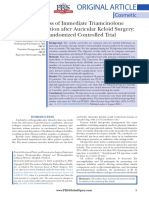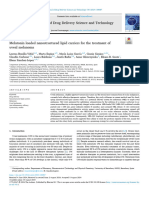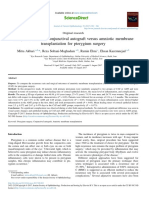Jurnal Penelitian DR Eko
Jurnal Penelitian DR Eko
Uploaded by
Eko WidayantoCopyright:
Available Formats
Jurnal Penelitian DR Eko
Jurnal Penelitian DR Eko
Uploaded by
Eko WidayantoOriginal Description:
Original Title
Copyright
Available Formats
Share this document
Did you find this document useful?
Is this content inappropriate?
Copyright:
Available Formats
Jurnal Penelitian DR Eko
Jurnal Penelitian DR Eko
Uploaded by
Eko WidayantoCopyright:
Available Formats
DOI : 10.35124/bca.2019.19.S2.
4889
Biochem. Cell. Arch. Vol. 19, Supplement 2, pp. 4889-4897, 2019 www.connectjournals.com/bca ISSN 0972-5075
INTRACAMERAL INJECTION OF LIMBAL MESENCHYMAL STEM CELLS
CONDITIONED MEDIA (LMSCs-CM) IMPROVE CLINICAL OUTCOME
WITH DELAYED ON Na-K ATPase CORNEAL ENDOTHELIAL PUMP
RECOVERY IN PHACOEMULSIFIED RABBIT EYES
Eko Widayanto1, Nurwasis1, Dicky Hermawan1, Arief Fidianto1, Paramita Putri1, Yuyun Rindiastuti1,
Willy Sandhika2, Igo Syaiful Ihsan3, Hendrian D. Soebagdjo1 and Evelyn Komaratih1
1
Department of Ophthalmology, Faculty of Medicine, Universitas Airlangga/ Dr. Soetomo General Academic Hospital,
Surabaya, Indonesia.
2
Department of Pathological Anatomy, Faculty of Medicine, Universitas Airlangga/ Dr. Soetomo General Academic Hospital,
Surabaya, Indonesia.
3
Stem Cell Research and Development Center, Universitas Airlangga, Surabaya, Indonesia.
email:ekowiopthal@gmail.com
(Received 11 August 2019, Revised 20 October 2019, Accepted 25 October 2019)
ABSTRACT : To investigate the effect of LMSCs-CM on central corneal thickness (CCT) and Na+/K+ ATPase of endothelial
cells expression inphacoemulsifiedrabbit eyes. This was a true experimental laboratory study on rabbits using a pre and post-
test control group design. Approximately 24 rabbit eyes were exposed to phacoemulsification ultrasound, then randomly divided
into 2 groups. The control group was injected using 0.2 ml of physiological saline (BSS) intracamerally, while the treatment
group was injected with 0.2 LMSCs-CM intracamerally. Central corneal thickness was evaluated on the 3rd day after treatment,
followed by enucleation to analyzed Na+/K+ ATPase expression using immunohistochemistry.The LMSCs-CM significantly
reduced corneal edema and inflammation resulting in clinical improvement. There was no mean difference of CCT between
groups (p = 0.372, α>0.05). However, CCT was higher in the control group (62.00 ± 27.41) when compared to the treatment
group (50.00 ± 36.45 um). Similarly, the expression of Na + / K + ATPase in both groups was not significantly different (p =
0.973, α>0.05). After 3 days, LMSCs-CM exerted clinical improvements, but had a delay in functional recovery, in regards to
Na+/K+ ATPase expression in the corneal endothelial cells.
Key words : Limbalmesenchymal stem cells (LMSC) conditioned media, Na+/K+ ATPase pump, endothelial cells, corneal thickness.
INTRODUCTION and 6.4% after the same procedure was done by senior
Phacoemulsification is a commonly used cataract residents. The main therapeutic choice for corneal
extraction surgery method with a high success rate. A endothelial damage at present is keratoplasty. However,
study at Cicendo Eye Hospital in 2011 showed that 81% the main problem with this method is the high postoperative
of the patients with high myopia had good vision following cell loss when compared to penetrating keratoplasty.
the surgery. Endothelial damage resulting from this Another problem is the limited corneal donor available
procedure is influenced by various preoperative and globally, meaning that new methods are needed to improve
intraoperative factors. Preoperative factors that affect and increase the density of endothelial cell survival (Olson
corneal endothelial cell loss includes age and cataract et al, 1990; O’Brien et al, 2004; Zavala and Jaime, 2013;
grade (Hayashi et al, 1996; Budiman et al, 2011; Nancy Maggon et al, 2017).
and Joyce, 2012; Zavala and Jaime, 2013; Gupta et al, Corneal clarity is regulated by an active metabolic
2014). Blindness related to corneal abnormalities ranks pump from endothelial cells. This metabolic pump is
as the 4th leading cause of blindness globally, with a controlled by Na+/K+ ATPase, which is located in the
prevalence of 5.1%. Studies conducted by Pirazolli et al basolateral endothelial cell membrane. Stimulation of
found that phacoemulsification results in 16.67% loss of corneal endothelial cells from phase G1 to phase S
endothelial cells that are associated with trauma during becomes an important step in increasing the ability of
surgery. Other studies show an endothelial cell loss of 4- endothelial cell proliferation. Methods to achieve this
15% after phacoemulsification by experienced surgeons includes transformation of viral oncogenes, the addition
You might also like
- The Course of Dry Eye After Phacoemulsification Surgery: Researcharticle Open AccessDocument5 pagesThe Course of Dry Eye After Phacoemulsification Surgery: Researcharticle Open AccessDestia AnandaNo ratings yet
- European Multicenter Trial of The Prevention of Cystoid Macular Edema After Cataract Surgery in Nondiabetics: ESCRS PREMED Study Report 1Document11 pagesEuropean Multicenter Trial of The Prevention of Cystoid Macular Edema After Cataract Surgery in Nondiabetics: ESCRS PREMED Study Report 1salvadorNo ratings yet
- 784 2024 Article 5794Document14 pages784 2024 Article 5794carlos sanchezNo ratings yet
- Long-Term Outcome of Allogeneic Cultivated Limbal Epithelial Transplantation For Symblepharon Caused by Severe Ocular BurnsDocument10 pagesLong-Term Outcome of Allogeneic Cultivated Limbal Epithelial Transplantation For Symblepharon Caused by Severe Ocular BurnsAngelica SerbulNo ratings yet
- Journal 5Document9 pagesJournal 5Zafira NstNo ratings yet
- Pi Is 0161642009014523Document2 pagesPi Is 0161642009014523Leni LukmanNo ratings yet
- Cotofana GlabellaDocument9 pagesCotofana GlabellaRubén DaríoNo ratings yet
- Untitled 3Document10 pagesUntitled 3Satya AsatyaNo ratings yet
- Journal of Periodontology - 2022 - Monje - Significance of Barrier Membrane On The Reconstructive Therapy ofDocument13 pagesJournal of Periodontology - 2022 - Monje - Significance of Barrier Membrane On The Reconstructive Therapy of安西 泰規No ratings yet
- The Effectiveness of Immediate Triamcinolone Acetonide Injection After Auricular Keloid Surgery: A Prospective Randomized Controlled TrialDocument8 pagesThe Effectiveness of Immediate Triamcinolone Acetonide Injection After Auricular Keloid Surgery: A Prospective Randomized Controlled TrialMarande LisaNo ratings yet
- 044040387Document5 pages044040387Hykma Purple CliquersPharmacyNo ratings yet
- International Journal of Ophthalmology and Clinical Research Ijocr 5 088Document6 pagesInternational Journal of Ophthalmology and Clinical Research Ijocr 5 088Nurfarahin MustafaNo ratings yet
- Raman Spectroscopy EV GeneralDocument9 pagesRaman Spectroscopy EV Generaljanarthanan.supramaniam1No ratings yet
- Cornea 38 1589Document6 pagesCornea 38 1589Nur LitaNo ratings yet
- Anterior Vitrectomy and Partial Capsulectomy Anterior Approach To Treat Chronic Postoperative EndophthalmitisDocument3 pagesAnterior Vitrectomy and Partial Capsulectomy Anterior Approach To Treat Chronic Postoperative EndophthalmitisSurendar KesavanNo ratings yet
- MataDocument16 pagesMataIslah NadilaNo ratings yet
- Journal PterygiumDocument15 pagesJournal Pterygiumbeechrissanty_807904No ratings yet
- AnotherDocument11 pagesAnotherTudor DumitrascuNo ratings yet
- Safety and Efficacy of Double Lamellar Keratoplasty For Corneal PerforationDocument12 pagesSafety and Efficacy of Double Lamellar Keratoplasty For Corneal PerforationHany ZainiNo ratings yet
- Jurnal MataDocument4 pagesJurnal MatamarinarizkiNo ratings yet
- Cotofana 2021Document9 pagesCotofana 2021Emrys1987No ratings yet
- Japid 14 26Document6 pagesJapid 14 26rikaNo ratings yet
- Exercise Alleviates Neovascular Age Related MaculaDocument14 pagesExercise Alleviates Neovascular Age Related MaculaW Antonio Rivera MartínezNo ratings yet
- Pe Rich On DR It Is of The Auricle and Its ManagementDocument6 pagesPe Rich On DR It Is of The Auricle and Its ManagementmitaNo ratings yet
- Sauer Bier 2010Document10 pagesSauer Bier 2010abdelrahman s.hassopaNo ratings yet
- Differences Between Children and Adults With Otitis Media With Effusion Treated With CO Laser MyringotomyDocument7 pagesDifferences Between Children and Adults With Otitis Media With Effusion Treated With CO Laser MyringotomyIndra PratamaNo ratings yet
- Modified AcceptedDocument28 pagesModified Acceptedaarushi singhNo ratings yet
- tmpC47C TMPDocument4 pagestmpC47C TMPFrontiersNo ratings yet
- Jurnal Mata 5Document6 pagesJurnal Mata 5Dahru KinanggaNo ratings yet
- Efeito Das Membranas de Colágeno Reticuladas Versus Não Reticuladas No Osso: Uma Revisão SistemáticaDocument10 pagesEfeito Das Membranas de Colágeno Reticuladas Versus Não Reticuladas No Osso: Uma Revisão SistemáticaJuliana Gomes BarretoNo ratings yet
- 35 Iajps35062018Document6 pages35 Iajps35062018Rd RjNo ratings yet
- Amniotic Membrane Transplantation As An Adjunct To Medical Therapy in Acute Ocular BurnsDocument8 pagesAmniotic Membrane Transplantation As An Adjunct To Medical Therapy in Acute Ocular BurnsDebby Astasya AnnisaNo ratings yet
- CMC - Tear Film StabilityDocument10 pagesCMC - Tear Film StabilityTushar BatraNo ratings yet
- Kobia Acquah Et Al 2022 Prevalence of Keratoconus in Ghana A Hospital Based Study of Tertiary Eye Care FacilitiesDocument10 pagesKobia Acquah Et Al 2022 Prevalence of Keratoconus in Ghana A Hospital Based Study of Tertiary Eye Care FacilitiesEugene KusiNo ratings yet
- ARGO Protocol Int OphthalmologyDocument14 pagesARGO Protocol Int OphthalmologyvisioengineeringNo ratings yet
- The Open Access Journal of Science and TechnologyDocument6 pagesThe Open Access Journal of Science and TechnologyNatalia SilahooyNo ratings yet
- Keratopati BulosaDocument7 pagesKeratopati BulosaShafira LusianaNo ratings yet
- Intracameral Mydriatics Versus Topical Mydriatics in Pupil Dilation For Phacoemulsification Cataract SurgeryDocument5 pagesIntracameral Mydriatics Versus Topical Mydriatics in Pupil Dilation For Phacoemulsification Cataract SurgeryGlaucoma UnhasNo ratings yet
- 1 s2.0 S1773224724007263 MainDocument12 pages1 s2.0 S1773224724007263 Mainsharpplay675No ratings yet
- Corticosteroids For Bacterial Keratitis - The Steroids For Corneal Ulcers Trial (SCUT)Document8 pagesCorticosteroids For Bacterial Keratitis - The Steroids For Corneal Ulcers Trial (SCUT)Bela Bagus SetiawanNo ratings yet
- UntitledDocument15 pagesUntitledinaNo ratings yet
- Ijo 70 3967Document2 pagesIjo 70 3967Pratik ThakerNo ratings yet
- Experimental Study On Cryotherapy For Fungal Corneal Ulcer: Researcharticle Open AccessDocument9 pagesExperimental Study On Cryotherapy For Fungal Corneal Ulcer: Researcharticle Open AccessSusPa NarahaNo ratings yet
- Evaluation of The Effectiveness of Collagen Membrane in The Management of Oro Antral FistulaCommunication A Clinical StudyDocument8 pagesEvaluation of The Effectiveness of Collagen Membrane in The Management of Oro Antral FistulaCommunication A Clinical StudyAthenaeum Scientific PublishersNo ratings yet
- tmpF7AC TMPDocument4 pagestmpF7AC TMPFrontiersNo ratings yet
- Desdiferenciacion Epitelial Qeratoquiste Marsupializacion 03Document6 pagesDesdiferenciacion Epitelial Qeratoquiste Marsupializacion 03Daniel BermeoNo ratings yet
- Comparison of Free Conjunctival Autograft Versus Amniotic Membrane Transplantation For Pterygium SurgeryDocument5 pagesComparison of Free Conjunctival Autograft Versus Amniotic Membrane Transplantation For Pterygium SurgeryTri Novita SariNo ratings yet
- Efficacy and Toxicity of Intravitreous Chemotherapy For Retinoblastoma: Four-Year ExperienceDocument8 pagesEfficacy and Toxicity of Intravitreous Chemotherapy For Retinoblastoma: Four-Year ExperienceSlr RandiNo ratings yet
- Perioperative Antibiotic Use in Sleep Surgery: Clinical RelevanceDocument10 pagesPerioperative Antibiotic Use in Sleep Surgery: Clinical RelevanceBRENDA VANESSA TREVIZO ESTRADANo ratings yet
- 015 7851Document6 pages015 7851dradnanahmad82No ratings yet
- MedicinaDocument14 pagesMedicinainaNo ratings yet
- Lens: Management of Cataract Surgery, Cataract Prevention, and Floppy Iris SyndromeDocument16 pagesLens: Management of Cataract Surgery, Cataract Prevention, and Floppy Iris SyndromeMagny DcrNo ratings yet
- Chitosan Nanoparticles ThesisDocument12 pagesChitosan Nanoparticles Thesisbufukegojaf2100% (2)
- Effect of Heparin in The Intraocular IrrigatingDocument3 pagesEffect of Heparin in The Intraocular IrrigatingAnonymous ZSUp6UFQDNo ratings yet
- A Clinicopathological Study of Vernal Conjunctivitis in Urban and Rural Areas of Eastern India: A Hospital Based StudyDocument8 pagesA Clinicopathological Study of Vernal Conjunctivitis in Urban and Rural Areas of Eastern India: A Hospital Based StudyMuhammad AbdillahNo ratings yet
- 2 YdcDocument8 pages2 YdcŞahin ŞahinNo ratings yet
- Transplantation of Conjunctival Limbal Autograft and Amniotic Membrane Vs Mitomycin C and Amniotic Membrane in Treatment of Recurrent PterygiumDocument6 pagesTransplantation of Conjunctival Limbal Autograft and Amniotic Membrane Vs Mitomycin C and Amniotic Membrane in Treatment of Recurrent PterygiumFrc 'Hario' FanachaNo ratings yet
- Advantages and Limitations of Endoscopic Septoplasty Experience of 120 CasesDocument6 pagesAdvantages and Limitations of Endoscopic Septoplasty Experience of 120 CasesInternational Journal of Innovative Science and Research Technology100% (1)
- Anti-Aging Therapeutics Volume XIVFrom EverandAnti-Aging Therapeutics Volume XIVRating: 3 out of 5 stars3/5 (1)
- Stem Cell Biology and Regenerative Medicine in OphthalmologyFrom EverandStem Cell Biology and Regenerative Medicine in OphthalmologyStephen TsangNo ratings yet
- Legal TranslationDocument38 pagesLegal TranslationBayu Dewa Murti100% (2)
- The Shabd Yoga TechniqueDocument12 pagesThe Shabd Yoga Techniquetenshun80% (5)
- Unlearning ExercisesDocument119 pagesUnlearning Exercisescid leana morales100% (1)
- Iowa Standards For School Leaders April 10, 2008Document1 pageIowa Standards For School Leaders April 10, 2008api-244230886No ratings yet
- Wondershare Quiz Maker StepsDocument4 pagesWondershare Quiz Maker StepsNorih Usman100% (1)
- List of Irregular Verbs: Present Past Past Participle SpanishDocument3 pagesList of Irregular Verbs: Present Past Past Participle SpanishIngeniería CitemacNo ratings yet
- InfluenceDocument8 pagesInfluencexornophobeNo ratings yet
- GIS For Sustainable-Development PDFDocument30 pagesGIS For Sustainable-Development PDFSandyhendyNo ratings yet
- Electronic ToysDocument8 pagesElectronic ToysAmalia ZahraNo ratings yet
- The Developed Concept of Service Marketing Mix: A Literature SurveyDocument17 pagesThe Developed Concept of Service Marketing Mix: A Literature SurveyShakti Kumar SeechurnNo ratings yet
- Melody Mae LoyolaDocument2 pagesMelody Mae LoyolaAnonymous 7FfIQAy9No ratings yet
- All The Exam History of English 2020Document3 pagesAll The Exam History of English 2020Наталя ДуткевичNo ratings yet
- Abdul Sattar 2018Document48 pagesAbdul Sattar 2018ABDUL sattarNo ratings yet
- Lab #10: Dissolved Oxygen Levels in Natural Waters: Date: Name: Student Id: Co-WorkerDocument5 pagesLab #10: Dissolved Oxygen Levels in Natural Waters: Date: Name: Student Id: Co-WorkerCuong NguyenNo ratings yet
- Lymphoma and HIVDocument20 pagesLymphoma and HIVALEX NAPOLEON CASTA�EDA SABOGAL100% (1)
- Circumcision: Encep Ivan SDocument46 pagesCircumcision: Encep Ivan SEncep Ivan SetiawanNo ratings yet
- Question Answers: Q1: Define Research? What Are The Characteristic of Research? A: MeaningDocument42 pagesQuestion Answers: Q1: Define Research? What Are The Characteristic of Research? A: MeaningjayNo ratings yet
- The Role of Ijtihad in Modern WorldDocument75 pagesThe Role of Ijtihad in Modern Worldbashir_abdi100% (2)
- Kamus ManusiaDocument822 pagesKamus ManusiaAhmad Abdullah100% (1)
- LitDocument11 pagesLitasefsdffNo ratings yet
- The Reading ManiaDocument14 pagesThe Reading Maniasarahindia33No ratings yet
- Online Application Form .General Details: Appln No: 2021029471Document4 pagesOnline Application Form .General Details: Appln No: 2021029471TEJAS PNo ratings yet
- Biology Thesis ProposalDocument7 pagesBiology Thesis Proposaljenniferthomasbatonrouge100% (2)
- SB Order 12-2020 - SBDocument4 pagesSB Order 12-2020 - SBBaskar ANgadeNo ratings yet
- H0FL-S01100SN User's Manual V1.4Document45 pagesH0FL-S01100SN User's Manual V1.4AdeyemiNo ratings yet
- Menu DiscriptionDocument16 pagesMenu Discriptionsultanur rahmanNo ratings yet
- Opm Filipino ComposersDocument35 pagesOpm Filipino ComposersEmmanuel Miranda DauzNo ratings yet
- Advanced Educational PsychologyDocument209 pagesAdvanced Educational PsychologyManichander100% (2)
- 1Document2 pages1berkciftci00No ratings yet
- Depression AssignmentDocument8 pagesDepression AssignmentNidhi MalviyaNo ratings yet

























































































